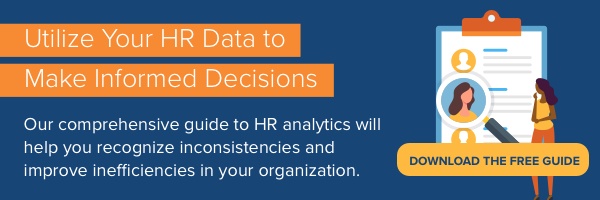The latest advances in modern technology mean you now have access to dynamic tools that support a deeper analysis of your workforce data. In fact, HR data analytics can provide you with greater visibility into your workforce and enable targeted, data-driven decisions about HR programs and initiatives. But what exactly is HR analytics, and how can you use it in your organization?
What Is HR Analytics?
HR analytics is the sum of data that supports HR analysis and decision-making. With the help of HR analytics, you don’t need to rely on anecdotal observations or guesswork to improve the effectiveness of HR activities. Instead, you can measure and report people data to help you better understand your workforce.
You can also use HR data analytics to identify trends and patterns in processes associated with employee pay, benefits, training, and other areas. HR analytics can help you make improvements in just about every area of human capital management, including:
- Recruitment and onboarding: The processes used for attracting and hiring talent.
- Compensation and benefits: The metrics and activities covering all areas of rewards and recognition.
- Performance management and engagement: The mechanisms for measuring and improving employee performance and commitment.
- Learning and development: The activities designed to build employee skills and capabilities.
How HR Data Analytics Improves Decision-Making
HR analytics will only be helpful to your organization if you have the tools to understand and use the data. Moreover, having new technology doesn’t guarantee you’ll be able to draw actionable insights from your HR data. A Deloitte study found that although 74 percent of surveyed HR and IT executives rated cloud-based HR technology as important, only 26 percent said they used technology and analytics effectively.
To ensure you effectively use HR data analytics to get the most value from it, it is essential to consider the many ways analytics can help you manage your workforce. You don’t necessarily need a team of analytics professionals to get started. You can immediately begin using HR analytics to identify solutions to your most pressing workforce management challenges.
Here are some examples of the ways you can use HR data analytics to improve decision-making:
Streamline recruitment and onboarding processes.
Given the need to compete for talent, your organization can use HR data analytics to discover the best methods for sourcing, evaluating, and selecting hires. Even after hiring, you'll want to make sure you are onboarding employees properly. For example, you can use applicant tracking data to understand:
- Which sources yield the best candidates.
- How long it takes to hire a candidate.
- What each hire costs to attract, select, and onboard.
Improve payroll management.
As the largest expense in most organizations, payroll costs require careful oversight and management. You can use HR analytics to report payroll expenses and track overtime costs by position, department, and location. With access to data to break down and analyze your total payroll expenses, you can consider policy changes to manage labor costs more effectively.
Support diversity and inclusion goals.
A 2021 HR Policy Association survey found that managing diversity and inclusion was the top concern named by HR executives. HR data analytics can support the development of a more diverse and inclusive culture by tracking metrics such as the diversity of new hires and the degree of pay equity among employees. You can also use HR analytics technology to generate Equal Employment Opportunity Commission (EEOC) reports your organization may be required by law to complete.
Examine benefits for cost-effectiveness.
HR data analytics helps you determine if the benefits you offer are effectively meeting employee needs. For example, you can generate reports that tell you which benefits are most in-demand among employees. You can also use data analytics to calculate your total benefits expenses and determine if there are areas in which you can cut costs but continue to offer competitive and comprehensive benefits.
Measure the success of training and development activities.
Offering employees varied opportunities to learn and grow is critical to developing a highly skilled and capable workforce. Using HR analytics to track employee training hours and promotion rates over time, you can see if your current employee development initiatives are working and where additional training may be needed.
Understand key drivers of engagement.
You can use HR data analytics to determine employee engagement levels and the factors that may be contributing to poor engagement. For example, you can measure engagement survey results and evaluation feedback, and compare the results to prior years. You can also run reports that measure two of the key signs of low engagement: absenteeism and turnover. By tracking these metrics, you can potentially identify areas of the organization in which employees are not as engaged as they could be.
Use offboarding feedback to improve the employee experience.
Employees leaving the organization can offer useful feedback to help you make improvements for the existing workforce. For example, by standardizing exit interview questions and capturing employee responses, you can discover key opportunities for improvements to your current processes.
Transform Your Workforce Management Decision-Making
HR analytics offers many opportunities to improve your talent management activities—from recruitment and onboarding to employee engagement and development. For more insights, read our guide: How to Use HR Analytics for Better Workforce Management.


